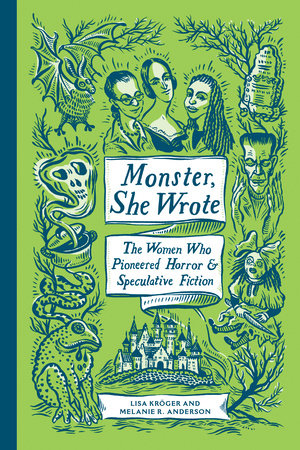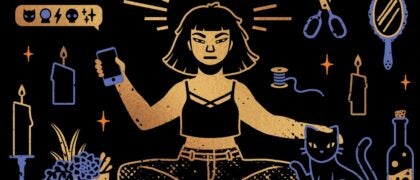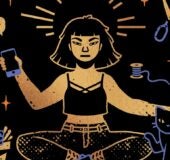IntroductionWhy are women great at writing horror fiction? Maybe because horror is a transgressive genre. It pushes readers to uncomfortable places, where we aren’t used to treading, and it forces us to confront what we naturally want to avoid.
And women are accused of being transgressive all the time—or, at the very least, they are used to stepping outside of the carefully drawn boundaries that society has set for them. Women are told what to do and who to be. Women are taught to be sweet, to raise children, to stay in their place. Women are pushed to the edges of society, where they are expected to keep their mouths shut and their heads down. The marginalization of women may have been more overt in the past, at times when women couldn’t vote or own property or work outside the home, but it still happens today. Women are still instructed to be good girls.
In any era, women become accustomed to entering unfamiliar spaces, including territory that they’ve been told not to enter. When writing is an off-limits act, writing one’s story becomes a form of rebellion and taking back power. Consider, for example, Margaret Cavendish, who in the 1600s brazenly wrote about science and philosophy, two subjects then considered the purview of only male minds. More recently, Jewelle Gomez brought an African American and lesbian perspective to the vampire tale, which had long been the province of European male protagonists. Today, writers like Carmen Maria Machado and Helen Oyeyemi subvert the so-called safe storytelling formats of the fairy tale and the supernatural yarn, adding women’s voices to these traditional narrative forms.
For women especially, writing is often a kind of noncompliance, which calls to mind the prisoners in the comic book series
Bitch Planet by writer Kelly Sue DeConnick and artist Valentine De Landro (Image Comics, 2014–17). The comic is brilliant—it tells a female-driven dystopian story about women sent to a prison planet as punishment for being noncompliant. What a great word to describe the women in this book.
The writers you’ll meet in
Monster, She Wrote are all rule breakers. And here’s the funny thing: society doesn’t always pay attention to what’s happening over there on the edges. So while society was ignoring them, they were taking up their pens. While everyone else has been doing their own thing, women have been doing theirs, crafting tales about scientifically reanimated corpses, ghosts of aborted children, postapocalyptic underground cities.
Horror has been penned by men and women alike, but it’s important to acknowledge that women have been contributing to the genre since its inception. As you’ll discover in the following pages, the horror genre that readers love today would likely be unrecognizable without the contributions of these women.
These misbehaving women who write horror in all its nasty forms.
The Queen of HorrorShirley Jackson 1916-1965
In 1948, the
New Yorker published a short story by a then-unknown writer. The tale, about an ordinary town with a sinister secret, so outraged readers that the magazine reported receiving more negative mail than ever before, including many subscription cancellations.
That story was “The Lottery” by Shirley Jackson, which went on to become one of the most famous short stories in American literature.
Though Jackson had been an obsessive writer since her youth and began publishing her writing during college, “The Lottery” made her a household name. For decades she received letters about it, which typically fell into one of three categories: bewilderment, speculation, and “plain old-fashioned abuse.”
The New England setting of the story was an integral part of Jackson’s writing, which often features main characters who are outsiders and find themselves persecuted in a hostile small-town environment. This was an experience familiar to Jackson.
Born in 1916, Jackson spent her childhood in California. She met her husband, the literary critic and professor Stanley Edgar Hyman, at Syracuse University, where they were students. The couple married in 1940 and moved several times before settling in 1945 in North Bennington, Vermont, where Hyman took a faculty position at Bennington College. She wrote, in what has become a famous anecdote from her life, that when checking into a hospital for the birth of her third child, the nurse asked Jackson what her occupation was. Jackson replied that she was a writer, to which the nurse said, “I’ll just put down housewife.”
The truth was that Jackson always struggled against her roles as wife and mother—or, to be more accurate, the roles that others cast her in. Professionally she was a successful author, but at home in North Bennington, she was Hyman’s wife and the mother of four children. Her husband expected her to play the part of faculty wife: to maintain the household, to rear the children, to cook, to clean, and to entertain people he brought into their home. The residents of the college town never quite accepted her as one of their own, which likely informed how she wrote about various groups’ intolerance of outsiders (see: the stone-wielding townsfolk in “The Lottery”).
Hyman controlled the family’s finances, but often it was Jackson’s income that kept them afloat. Jackson’s posthumously published collection
Come Along with Me (Viking, 1968; Penguin, 1995 reprint) contains an anecdote about a time the family needed a new refrigerator. So she wrote a story, was paid, and bought the fridge. In this way, writing was, for Jackson, a real kind of magic. Hyman encouraged his wife’s work, especially because it supplemented his income. But when eventually her career eclipsed his, Hyman no longer tolerated her success and belittled her in front of his university colleagues. What’s more, he was frequently unfaithful, being particularly fond of his former students.
It’s no wonder that Jackson wrote about women who were lonely and ostracized. Her characters are haunted, sometimes literally and sometimes figuratively, by pasts they can’t escape. Jackson became a master of both types of hauntings, the supernatural and the psychological, the interior and the exterior.
Haunted Housekeeping Haunted house stories are a staple in horror literature; nearly every writer of the genre has told one or two. None have come as close to perfection as Jackson in creating houses that loom larger than their actual size, describing a past that haunts the present. What also sets her domestic stories apart is how quickly and effectively the mundane scenarios she depicts turn violent. Even a setting as seemingly humdrum as a grocery store transforms into a downright bloodbath in
We Have Always Lived in the Castle, her 1962 novel about two sisters living in a family home following an infamous multiple murder.
“The Lottery” established Jackson as reigning queen of the horror genre, though she wrote everything from campus novels to darkly comic domestic sketches about family life. These sketches were first published in magazines like Good Housekeeping and Woman’s Day and, later, in the books Raising Demons (Farrar, Straus & Cudahy, 1957; Penguin Books, 2015) and Life among the Savages (Farrar, Straus & Cudahy, 1953; Penguin Books, 2015). She cemented her status as a titan of terror with the 1959 publication of The Haunting of Hill House (Viking), which was adapted in 1963 into the film The Haunting, which then developed a cult following of its own. Director Jan de Bont brought a less popular adaptation to the screen in 1999. And in 2018, the Netflix series The Haunting of Hill House took the bare bones ofJackson’s story into new territory.
Hill House is a lovely work of ambiguity. Four characters from different walks of life converge on the titular property, which has a bad past and a bad reputation. Eleanor Vance, the protagonist, has answered an advertisement posted by Dr. Montague seeking assistants for a haunted house investigation. She sees it as the first adventure of her life, which until that point she has spent taking care of her invalid mother. Once the action begins, it’s hard to tell if the four people are cracking under the strain of their isolation in the bizarre mansion, or if the house truly is haunted. It doesn’t help that every angle in the building is off by a few degrees, and the decorations are . . . well, let’s just say, strange. In addition to the usual cold spots, bangs and knocks, and even a séance of sorts, Jackson adds Eleanor’s internal monologues in which she struggles to understand her morbid attraction to Hill House.
With this book and others, Jackson drafted a blueprint for the modern haunted house in both literature and film. Stephen King modeled his Overlook Hotel in
The Shining after another of Jackson’s creepy settings, the Halloran house in
The Sundial (Farrar, Straus & Cuddahy, 1958). Moreover, King wrote at length about his debt to Jackson in his nonfiction ode to the horror genre,
Danse Macabre (Gallery Books reprint, 2010), and in
On Writing (Scribner reprint, 2010), his memoir on his chosen craft. Other authors who have cited Jackson as an influence include Neil Gaiman, Richard Matheson, and Sarah Waters.
If
The Haunting of Hill House was the definitive haunted house novel, then Jackson’s final completed novel,
We Have Always Lived in the Castle (Viking, 1962), cemented her in the Gothic and horror traditions. Time magazine named it one of the ten best novels of 1962. The story focuses on the Blackwood sisters, Constance and Mary Katherine (nicknamed Merricat), who live with their infirm Uncle Julian in their fenced-in family estate outside of a New England town. Uncle Julian’s poor health and the scorn the townspeople feel for the surviving Blackwoods are the result of a tragedy that occurred six years earlier. One night at supper, four members of the Blackwood family—the girls’ parents, brother, and aunt—were poisoned and died. Constance, who hadn’t used the arsenic-laced sugar on the dinner table, was arrested for the crime but not indicted. The townspeople believe she got away with murder. Her younger sister Merricat had been sent to her room without dinner on that fateful night and now is the only member of the household who ventures outside; she also practices magic rituals in order to keep Constance safe. Out of the blue, their cousin Charles swoops in, believing he is the rightful inheritor of the estate, and establishes himself as patriarch.
Castle is often praised, especially for its protagonist. Merricat Blackwood is an outsider, like many of Jackson’s women, but she maintains an imaginative spirit and a fierce devotion to defending her sister and her home. Fans of the horror writer Paul Tremblay will recognize similarities in his protagonist Merry in
A Head Full of Ghosts (William Morrow, 2015).
The Blackwood sisters’ existence at the margins of their community reflects Jackson’s own experience. She didn’t quite fit in with the other wives of her small university town; she spent her days writing and tending children, but her nights were filled with more exotic fare. A lover of the occult, Jackson gave tarot readings to friends and family. She claimed not to believe in ghosts but she owned a crystal ball and a Ouija board and seemed to relish her reputation as a “witch.” Whether or not she practiced witchcraft is debatable.
Shirley Jackson may not have been understood by the people who knew her, but her literary legacy is indisputable. As an example, consider the Shirley Jackson Awards, a juried accolade that has been given annually since 2007 for excellence in horror, thriller, and dark fantasy fiction.
Reading ListNot to be missed: Need some Shirley Jackson in your life? Honestly, who doesn’t? Jackson is best known for her novels
The Haunting of Hill House and
We Have Always Lived in the Castle, both available from Penguin Classics. “The Lottery” can be found in
The Lottery and Other Stories, a 2009 Penguin reprint, among other editions. But Jackson’s other novels are criminally underread.
The Sundial is an apocalyptic tale with all the Gothic trappings: a family with a sordid past, a manor house with secrets, and a storm blowing in. Yet it avoids cliché thanks to a unique exploration of family relationships. The narrative quickly turns into psychological suspense, and readers must question whether the end of the world is, in fact, near. It is available in a 2014 Penguin edition, with a foreword by Victor LaValle.
Also try: As mentioned, the 1963 film adaptation of
Hill House has gained a fandom of its own. The ten-part 2018 Netflix series provides a fantastic reimagining (not a straight adaptation) of the novel that is well done and worth viewing.
Judy Oppenheimer’s
Private Demons (Ballantine Books, 1989) was the first full-length biography of Shirley Jackson. Oppenheimer interviewed Jackson’s family and friends for a more complete portrait than a mere blurb on a book jacket could offer. In it she focuses on Jackson’s supposed witchcraft and occult leanings...maybe a little too much. Ruth Franklin’s more recent and thoroughly engaging
Shirley Jackson: A Rather Haunted Life (Liveright, 2016) dives deep into Jackson’s personal papers and notes from the Library of Congress archive and interweaves insightful readings of her works into a sharp yet sympathetic biographical portrait. If you read only one biography of Jackson, make it Franklin’s.
Related work: In a testament to Jackson’s enduring allure, Susan Scarf Merrell’s murder mystery
Shirley (Blue Rider Press, 2014) features Jackson as a character. Like so many of Jackson’s novels, this is a psychological thriller, with a young girl at the center. When the girl disappears, Jackson is a suspect. The director Josephine Decker began adapting the novel to film in 2018, with actress Elisabeth Moss playing Shirley Jackson.
Copyright © 2019 by Lisa Kröger and Melanie R. Anderson. All rights reserved. No part of this excerpt may be reproduced or reprinted without permission in writing from the publisher.









